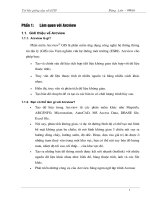Tài liệu giảng dạy CCNA - module 01 chapter 05 - Fundamentals of IP
Bạn đang xem bản rút gọn của tài liệu. Xem và tải ngay bản đầy đủ của tài liệu tại đây (773.97 KB, 47 trang )
1
Module 01
InterNetwork Overview
Chapter 05
Fundamentals of IP
2
Table of Content
1 Typical Features of OSI Layer 3
2 IP Addressing Fundamentals
3 Network Layer Utilities
3
1. Typical Features of OSI Layer 3
4
Routing overview
Routing is an OSI Layer 3 function.
Routing is the process of finding the most efficient path
from one device to another.
The primary device that performs the routing process is
the router.
Routers must maintain routing tables and
make sure other routers know of changes in
the network topology.
The router switches the packets to the
appropriate interface, adds the necessary
framing information for the interface, and
then transmits the frame.
5
Routing Logic: PC1 Sending to PC2
Token
Ring
10.1.1.1
PC1
R1
R2
R3
PC2
168.1.1.1
Destination Is
in another
Group; Send
to Nearby
Router.
My Route
to that Group Is
Out Serial Link.
My Route
to that Group Is
Out Frame
Relay.
Send Directly
to PC2
6
Network Layer and Data Link Layer
Encapsulation
Frame-Relay
Token
Ring
10.1.1.1
PC1
R1
R2
R3
PC2
168.1.1.1
Encapsulate
IP Packet in
Ethernet
Extract IP
Packet and
Encapsulate in
HDLC
Extract IP
Packet, and
Encapsulate in
Frame Relay
Extract IP
Packet, and
Encapsulate in
Token Ring
TR IP Packet
Eth IP packet
HDLC IP packet
FR IP packet
TR IP packet
7
Routing Protocol
•
Routing protocols allow routers to choose the best
path for data from source to destination.
•
Functions includes the following:
–
Provides processes for sharing route information.
–
Allows routers to communicate with other routers
to update and maintain the routing tables
8
IP Routing and Routing Protocols
Frame-Relay
150.150.3.0
Token
Ring
150.150.1.10
PC1
R1
R2
R3
PC2
150.150.4.10
Subnets Out interface Next hop IP
150.150.4.0 Serial 0 150.150.2.7
Subnets Out interface Next hop IP
150.150.4.0 Serial1 150.150.3.1
Subnets Out interface Next hop IP
150.150.4.0 Ethernet 0 N/A
150.150.2.0 .7
.1
.4
Default router: 150.150.1.4
9
2. IP Addressing Fundamentals
1
0
IP address classes
To accommodate different size networks and aid in classifying
these networks, IP addresses are divided into groups called
classes. This is known as classful addressing.
Different class addresses reserve different amounts of bits for the
Network and Host portions of the address
Class A Network Host
Octet 1 2 3 4
Class B Network Host
Octet 1 2 3 4
Class C Network Host
Octet 1 2 3 4
1
1
IP address classes: Class A
1
2
IP address classes: Class A
The first bit of a Class A address is always 0.
The first 8 bits to identify the network part of the
address.
Possible network address from 1.0.0.0 to
126.0.0.0
The remaining three octets can be used for the
host portion of the address.
Each class A network have up to 16,777,214
possible IP addresses( 2
24
-2)
1
3
IP address classes: Class B
1
4
IP address classes: Class B
The first 2 bits of a Class B address is always 10.
The first two octets to identify the network part of
the address.
Possible network address from 128.0.0.0 to
191.255.0.0 (2
14
)
The remaining two octets can be used for the
host portion of the address.
Class B network have up to 65.534 possible IP
addresses (2
16
-2)
1
5
IP address classes: Class C
1
6
IP address classes: Class C
The first 3 bits of a Class C address is always
110.
The first three octets to identify the network part
of the address.
Possible network address from 192.0.0.0 to
223.255.255.0.
The remaining last octet can be used for the host
portion of the address.
Class C network have up to 254 possible IP
addresses (2
8
-2) .
1
7
IP address classes: Summary
1.0.0.0 - 126.0.0.0 : Class A.
127.0.0.0 : Loopback network.
128.0.0.0 - 191.255.0.0 : Class B.
192.0.0.0 - 223.255.255.0 : Class C.
224.0.0.0 < 240.0.0.0 : Class D, multicast.
>= 240.0.0.0 : Class E, reserved.
1
8
How IP Addresses Are Grouped
Together
All IP addresses in the same group must not be separated
by a router.
IP addresses separated by a router must be in different
groups.
1
9
Why we need to divide network?
Network administrators sometimes need to divide
networks, especially large ones, into smaller networks:
Reduce the size of a broadcast domain.
Improve network security.
Implement the hierarchical managements.
So we need more network addresses for your network.
But I want the outside networks see our network as a
single network.
2
0
Without subnet
131.3.0.0
131.1.0.0
131.2.0.0
•
The smallest group is a single, entire Class A, B, or C network
number.
•
The NIC would be woefully short of assignable networks and NIC.
2
1
Divide network by three
131.108.3.0
•
The NIC can assign one or a few network numbers to an
organization, and then the organization can subdivide
those networks into subnets of more usable sizes.
2
2
Subnetting
To create a subnet address, a network
administrator “borrows” bits from the original
host portion and designates them as the subnet
field.
“Borrows” bits is always the leftmost host bit, the
one closest to the last network octet.
Subnet addresses include the Class A, Class B, or
Class C network portion, plus a subnet field and a
host field.
Subnet addresses are assigned locally, usually by
a network administrator.
2
3
Subnetting: Example
Class C Network address: 192.168.10.0
11000000. 101010000. 00001010. 00000000
N . N . N . H
11000000. 101010000. 00001010. 00000000
N . N . N . sN H
Class B Network address: 132.10.0.0
10000100. 00001010. 00000000. 00000000
N . N . N . H
10000100. 00001010. 00000000 00000000
N . N . sN H. H
Class A Network address: 10.0.0.0
00001010. 00000000. 00000000. 00000000
N . N . N . H
00001010. 00000000. 00000000. 00000000
N . sN . sN H. H
2
4
Establishing the subnet mask
address
“Extended Network Prefix”.
Give router the information to determines
which part of an IP address is the network field
and which part is the host field.
32 bits long, divided into four octets.
Network and Subnet portions all 1’s.
Host portions all 0’s.
2
5
Subnet mask: Example
Class C Network address: 192.168.10.100/255.255.255.0 (or /24)
IP Address 11000000. 101010000. 00001010. 01100100
N . N . N . H
AND operation
Default subnet
Mask
11111111. 11111111. 11111111. 00000000
Network address 11000000. 101010000. 00001010. 00000000
Class A Network address: 10.0.160.13/255.255.240.0 (or /20)
IP Address 00001010. 00000000. 10100000. 00001101
N . sN . sN H. H
AND operation
Subnet Mask 11111111. 11111111. 11111111. 00000000
Network address 00001010. 00000000. 10100000. 00000000









